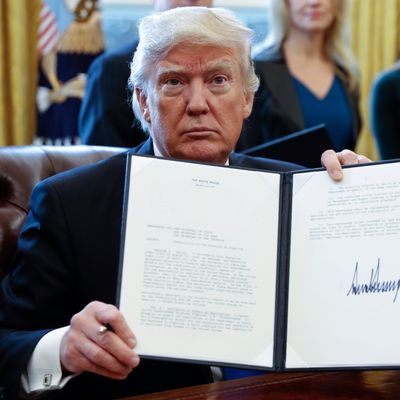
After using his presidential pen to restrict access to abortion worldwide, disrupt the provision of health care here at home, and christen his Inauguration Day a “National Day of Patriotic Devotion,” Donald Trump turned his attention on Tuesday to America’s pressing need for new oil pipelines.
With a pair of executive orders, the president reversed the Obama administration’s decisions on both the Keystone XL and Dakota Access pipelines. But the White House did not immediately make the text of the orders available to the public, and it’s unclear whether Trump’s endorsement will be enough to get the oil flowing.
For one thing, an executive order signed by George W. Bush in 2004 requires the State Department to lead a broad review of all cross-border pipelines before they’re approved. And it’s unclear whether Trump’s order explicitly alters that rule. According to sources who spoke with Politico, there was little communication between the Trump team and the State Department ahead of the executive order on the Keystone XL, which would carry Canadian tar sands from Alberta to Texas.
For another, Trump suggests that his approval of Keystone would be “subject to a renegotiation of terms by us” — an ostensible reference to his campaign vow to have the U.S. government confiscate 25 percent of the profits the pipeline produces. This would be a tall order, in both legal and political terms.
And then there’s the considerable opposition to the pipeline among landowners in deep-red Nebraska; the Cornhusker State regulators who need to be won over for the project to proceed; and the environmentalist movement that’s itching for a symbolic fight with the climate-change accelerator-in-chief.
The latter is also a formidable obstacle to the Dakota Access pipeline (DAPL). A coalition of environmentalists, the Standing Rock Sioux tribe, and Native American rights activists pressured the Obama administration into halting construction of the last leg of DAPL last December, pending further review of the environmental risks posed by the project. The Sioux claim that the pipeline threatens the tribe’s sacred land and water supply.
After the Obama administration’s action, thousands of protesters remained camped out near the proposed site of the pipeline’s construction, in anticipation of a potential reversal. According to The Wall Street Journal, several hundred additional protesters arrived at the main protest campsite last weekend.






























